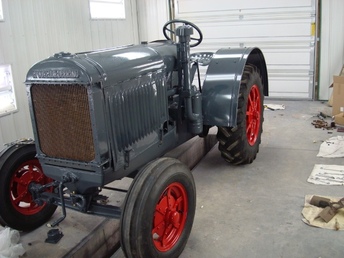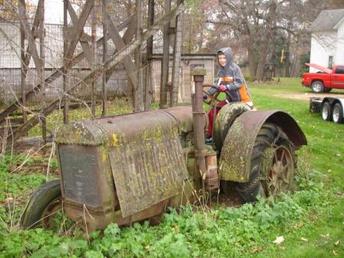Dave Koenigsfeld
Member
Finally!!!!!!!!!!!!!!!! As many of you know, we have been working on two McCormick-Deering 10-20 that were my Grandfather's. They probably sat in the fence row for 50 years. First we tackled the 1927 on rubber. New rims, new rubber, new fenders, new pistons, new sleeves, new valve guide tubes, crank turned, rebuilt governor, rebuilt mag and carb, new radiator, new bearings and all new felts. Almost every part offered by The Fordson House. Lots of body work.
The motor man drove 2 1/2 hours to help us set the timing and get it started. We couldn't get it to fire by cranking it so we gave it a tug and it started on the 1st rotation of the wheel. The next issue is that the clutch wouldn't disengage. Brand to lining that just wouldn't release. We held the brake to slip the clutch and try and wear it down but that didn't help either. We drove it around for about and hour. We killed the engined and hand crank started it about 5 times. After another round of carb setting changes and getting the mag setting correct so we could kill the motor, we couldn't hand start it but we didn't spend a lot of time at it since we went after the clutch.
Here is one video, hopefully the other displays too.
http://www.youtube.com/watch?v=lOl4gEp2VY4
After about 4 hours we got the new clutch out and put an older one back in, confirmed that we have clutch and quit for the night. Monday we will button up the clutch and clean up the tractor.
I'm sure I will have to play with the settings to find that sweet spot in the timing and the throttle to get it to start easy. The motor many insisted that the timing be set to fire just past TDC so that the motor would fire on the way down when starting. He said that this setting would never produce a kickback. This seems a bit different than the other information out there but the motor ran very smooth when we had it going.
the motor fired very strong. Spectators could definitely feel the compression standing 15-20ft away. We were all excited just driving it around. A big thanks to everyone on this board for all of the great information regarding these tractors. I think when I posted the serials numbers, someone abroad gave me the year of each tractor in about 20 minutes.
I will post more pictures next week of the tractor with all of the decals and cleaned up. Maybe a better video of it running but here are a couple that I took.
This summer, both tractors will be in a show at Roseville, IA. I will also take them back to the farm and take a photo of them in the same spot that they came from! A true before and after.
Dave


Motor starting video
The motor man drove 2 1/2 hours to help us set the timing and get it started. We couldn't get it to fire by cranking it so we gave it a tug and it started on the 1st rotation of the wheel. The next issue is that the clutch wouldn't disengage. Brand to lining that just wouldn't release. We held the brake to slip the clutch and try and wear it down but that didn't help either. We drove it around for about and hour. We killed the engined and hand crank started it about 5 times. After another round of carb setting changes and getting the mag setting correct so we could kill the motor, we couldn't hand start it but we didn't spend a lot of time at it since we went after the clutch.
Here is one video, hopefully the other displays too.
http://www.youtube.com/watch?v=lOl4gEp2VY4
After about 4 hours we got the new clutch out and put an older one back in, confirmed that we have clutch and quit for the night. Monday we will button up the clutch and clean up the tractor.
I'm sure I will have to play with the settings to find that sweet spot in the timing and the throttle to get it to start easy. The motor many insisted that the timing be set to fire just past TDC so that the motor would fire on the way down when starting. He said that this setting would never produce a kickback. This seems a bit different than the other information out there but the motor ran very smooth when we had it going.
the motor fired very strong. Spectators could definitely feel the compression standing 15-20ft away. We were all excited just driving it around. A big thanks to everyone on this board for all of the great information regarding these tractors. I think when I posted the serials numbers, someone abroad gave me the year of each tractor in about 20 minutes.
I will post more pictures next week of the tractor with all of the decals and cleaned up. Maybe a better video of it running but here are a couple that I took.
This summer, both tractors will be in a show at Roseville, IA. I will also take them back to the farm and take a photo of them in the same spot that they came from! A true before and after.
Dave


Motor starting video

